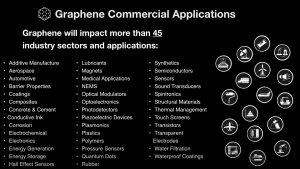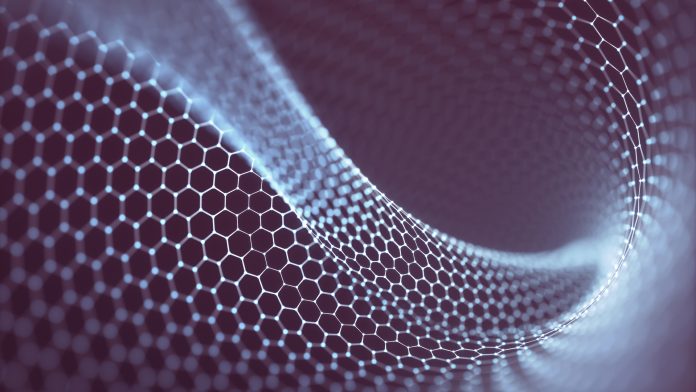Terrance Barkan, Executive Director of The Graphene Council, explains the great potential for graphene application and the need for investment to facilitate future innovation in the US and worldwide.
Based in the US with offices in Europe and South America, The Graphene Council was formed in 2013 to serve the global community of application developers, graphene producers and professionals, and end-users. The organisation provides graphene research and commercial application news and intelligence and works with R&D teams to identify the correct type of graphene material and supplier, from application concept to prototype development and testing.
To learn more about the work of The Graphene Council, Innovation News Network spoke to Terrance Barkan, Executive Director of The Graphene Council. Here, Barkan discusses the uses and applications of graphene and the current need for the US Government to invest in graphene innovation.
Can you tell us about the recent work of The Graphene Council? What are your current priorities and how do these compare with the aims of the council when it was first formed?
The Graphene Council’s main aim has always been consistent, and that is to advocate on behalf of the entire graphene sector worldwide. We were founded in August 2013, with the goal to represent the graphene sector as a neutral body, focused on research, development, and the application of graphene. Today that mission remains unchanged. How we achieve that, however, has advanced tremendously. We now represent more than 30,000 material scientists worldwide. Two-thirds of those are in the commercial realm and one-third are academic or university-based individuals.

We have been active for many years now in the setting of international standards for graphene. We are formal members of traditional standard setting bodies like the International Organization for Standardization (ISO), the International Electrotechnical Commission (IEC), and ASTM International. More recently, however, we have convened a task force of more than 100 volunteers to work on what we have called the Graphene Classification Framework. That framework builds on the existing international standards and adapts them to be more commercially relevant for today.
At the end of 2020, we conducted a comprehensive survey of over 800 stakeholders from around the world. That survey gave us a thorough overview of what is important to those working with and using graphene. Building on that, we launched our task force for the Graphene Classification Framework in April of 2021. We published our final results in November 2021, and we will make those results public for the traditional standard setting bodies to use and to codify as international official standards.
This is a huge milestone. We did this because the traditional standards were taking too long to come to fruition and be published. Also, we saw that the regulatory agencies had a poor understanding of the different types and forms of graphene materials and, therefore, they were having difficulty in regulating it, and providing approvals. When they have difficulty, their response is to not give an approval, which is a major obstacle.
The Graphene Classification Framework consists of five key elements. One is a list of material characteristics and properties that were deemed most relevant for commercial use and application. That is important because some of the traditional standard setting bodies are trying to be exhaustive in what they measure, but these are not practical for commercial use. This is because they might use techniques and equipment, for example, that is out of reach of many companies, or is too slow to be used for batch-to-batch processing.
Secondly, we have identified a preferred method of testing for each of these characteristics that we have found. We have also identified alternative methods where available. We give people an indication of what to test for, and then what method to use for testing.
Thirdly, we have a range of measurement values. For example, with graphene, that could be a single layer of carbon or up to ten layers. Then you have lateral flake size, the percentage of carbon content, level of oxidation, and whether or not it is functionalised, etc. When these factors are combined, you start to get groupings or types and forms of graphene materials. This also includes formats, if it is in a powder form or if it is in a dispersion, etc.
The fourth element is a normalised syntax to use. What that means is that we have a lot of companies that are creating unique and novel commercial terms for their material, but they are not useful for widespread application, as many of these terms only mean something for that one particular company. What we are looking at is a syntax that can be consistently used to describe materials, which includes things like the layer count and the lateral size, but also the production method, the raw material, or the source material. We will encourage the industry to use this syntax, and this will be especially useful for regulators when discussing different types of material.
Lastly, we will release a technical data sheet template that conforms to the Graphene Classification Framework. We will encourage companies to use it for the future of graphene innovation, so that there is a consistent way of reporting different types or forms of graphene material. This is to remove confusion in the market, to make it more transparent, to instil confidence in end users of this material, and to offer regulators a consistent way of having the material described.
Other areas that we have worked on for a long time include educating the end-user markets and informing them about developments in the graphene area. We do that primarily through webinars, of which we host at least one a month, either to highlight specific companies and the technical developments that they have made, or we focus on a class of materials. For example, we had a webinar on graphene oxide in general, and its different applications. These webinars have been attracting between 300 to over 500 participants per webinar, and we post the recordings of the webinars to our YouTube channel to educate the general public and potential end users about graphene.
What does the R&D landscape in the US look like currently and how is it evolving? What areas do you think need improvement?
Everyone knows about the Graphene Flagship, which is now reaching its last years of operation and has funded a tremendous amount of R&D throughout Europe. In Brazil, there is a strong national strategy for graphene development and research through national universities and in the private sector. The United States, however, has lacked a national strategy for graphene innovation development, and it has mainly been the responsibility of companies on an individual basis to take the initiative for research and development. This has resulted in a poorly co-ordinated sector, and, most importantly, the industrial and manufacturing base in the US does not have an appropriate level of awareness of how important this material is.

Now, with the current administration in the US, the landscape is changing because the National Nanotechnology Initiative (NNI) has recognised the importance of graphene and other 2D materials. They have taken efforts to better co-ordinate understanding of that throughout all US governmental departments, including the Department of Energy, Department of Transportation, Department of Defence, and many others. There are more than 20 national departments in the US that are part of the NNI consortium. The Graphene Council works with them, and we have made a presentation to these different US Government entities to make them aware of what graphene is, and how important it is, because it does not only have commercial implications but also national defence implications.
On the R&D side, we see applications moving forward in the space of composites. The Graphene Council is actively working with companies and universities to conduct testing of graphene materials in thermoset resins. For application in the concrete sector, we are also engaged with the American Concrete Institute, looking at how graphene innovation enhances the performance of cement and concrete applications.
We have also recently held a webinar on graphene in healthcare. This is a different type of graphene application, primarily in sensors and biosensors, using the single layer of carbon material as the sensing interface, and incorporating it in medical devices for diagnostics, monitoring, and sensing applications.
Do you think that graphene innovation in the US needs more investment?
Graphene innovation in the US definitely needs more investment, especially because most graphene companies are relatively small entities. Until a robust market has been proven, the graphene producers are not going to invest in capacity to scale. It becomes a ‘chicken and the egg’ scenario, where large customers are not going to place orders unless they know that the producers can meet the scale requirements. There is a bridge in between, where the application testing and validation phase needs to happen. That means taking graphene and using it in real-world applications and carrying out independent, third-party testing to validate it. If you can do that, then you will have customers and producers who work together to address the scale question.
I do not think we need government investment for scaling, but we do need government investment for testing, prototyping, and then also the testing that is needed for the health and safety verification, and the regulatory approval. This is an expensive stage that nobody wants to fund unless they know there is a commercial market, which is where the government should come into play.
Now, why should the US Government fund that level? It is because graphene is a strategic material with both economic and national defence applications. When you think of things like needing to make the national infrastructure more robust and the need to reduce CO2 emissions and embedded carbon, legacy materials will not solve these problems. We need materials that have a step-change improvement.
Graphene innovation is perfectly suited for this because it does not replace materials, it enhances them. That means you can use existing infrastructure, and existing processes and materials, and improve them with graphene. This will result in massive reductions in CO2 emissions, make the materials stronger, and also create a greater resistance to corrosion, so they are more robust. It is probably one of the best ways to achieve massive improvements for the least amount of investment, but it needs to be trialled and proven so that it becomes adopted.
What is important for people to understand is that there have been massive improvements in the ability of companies to produce graphene, consistently at high quality and high volume. We now have more than 10,000 metric tons (MT) per annum of existing capacity, and the ability to ramp up or scale up is there because, in many cases, you can simply replicate these production facilities. For some industries, in order to scale, you need to make larger pieces of kit. With graphene, however, most of the production facilities are not very big to begin with. To add capacity, you would simply replicate them, which is not that capital intensive and not that difficult technically.
I have two main messages I want to convey. The first is that, because of the improvement in scaling and as the market matures, the price for the material is reducing. It is a common misconception that graphene is too expensive to use. In cases like for cement and concrete, or using it as an additive in other applications, you often use tenths of a percent if not hundreds of a percent by weight. You are using a very small amount to drive a big impact. There are also other factors that offset the cost. If you can improve the performance of the material, you can often use less of the base material to begin with, which also lowers cost.
What applications can we expect to see the most progress in when it comes to future graphene innovation?
One is elastomers or rubber, which is an area that does not currently get a lot of attention. With the electrification of transportation, more and more vehicles are becoming battery powered, causing these cars to become heavier. They also accelerate faster than internal combustion cars, meaning they are much harder on the tyres. Now, we need tyres that are more robust without reducing traction or friction for safety reasons. Graphene additives for elastomers and rubber, specifically for car tyres, is an area of important application, because now our concern is that the debris that comes off the wear of the tyres is going to become an environmental issue. Graphene can improve the durability of tyres without reducing their level of friction and safety.

Another area that I expect will gain more interest is that of textiles. Graphene will be used to enhance the performance capabilities of textiles so that they last longer, have better thermal properties and to improve the wear in high-use areas. For example, for gloves in industrial settings. It is important to make a glove that gives better cut and abrasion resistance, and is still comfortable to wear, as the bulkiness is one of the most important reasons why some workers do not use their hand protection.
Another major application is energy storage. Batteries are important for many different areas as you have different form factors and different types of battery chemistry. When you have a lot more use of renewables, especially solar and wind power, those sources of power are not consistent. When you have a high period of generation, that energy needs to be captured and stored and this needs large capacity, deep cycle type energy devices. The type of batteries that are needed differ depending on the application area, which means that the chemistry also differs. Graphene has a role to play in all of these areas for energy storage, whether it is heat management, or because of the surface area and the energy density.
These are just some of the more than 45 different application areas we have identified to date.
Terrance Barkan
Executive Director
The Graphene Council
tbarkan@thegraphenecouncil.org
www.thegraphenecouncil.org
https://www.linkedin.com/in/terrancebarkan
Please note, this article will also appear in the eighth edition of our quarterly publication.









